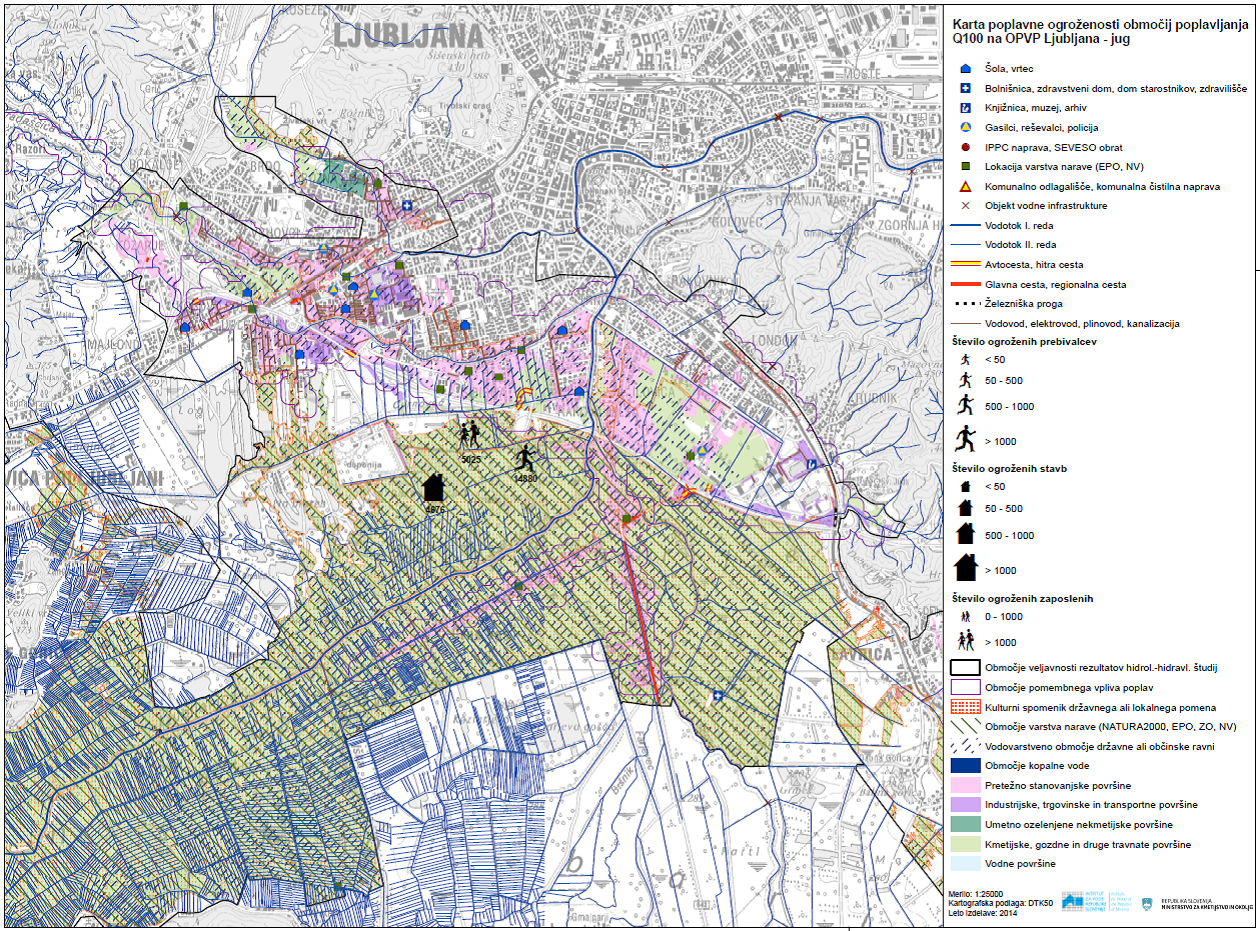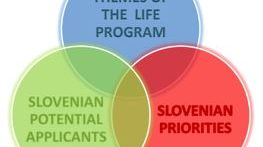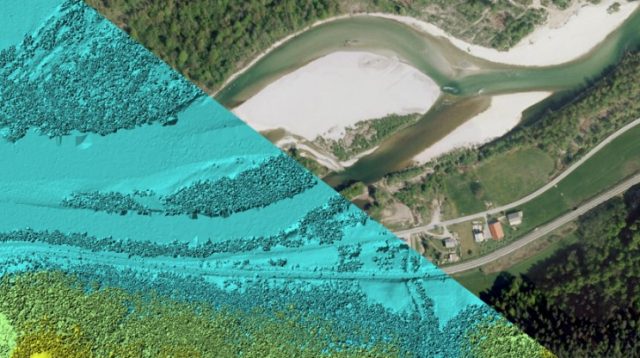Preparation of Maps of Flood Threats for the Areas of Significant Impact of Floods in the Republic of Slovenia

The task is based on the Framework Programme for Implementing the Directive on the Assessment and Management of Flood Risks for the Period of 2009–2015 (Ministry of the Environment and Spatial Planning, May 2009). The legal framework of our task is set out in Article 6(5) of Directive 2007/60/EC (OJ L 288), which was transposed into Slovenian law with Articles 11, 12 and 13 of the Decree on Establishment of Flood Risk Management Plans (Official Gazette of the RS, No. 7/2010) that was adopted on the basis of Article 60.a of the Act Amending the Waters Act (Official Gazette of the RS, No. 57/2008). The primary purpose of this task is to provide expert bases for determining objectives and measures for flood risk management planning in 61 areas of significant impact of floods in 2014 and 2015.
Articles 11, 12 and 13 of the Decree on FRMP define the method, content and timetable for the preparation of maps of flood risks and flood threats. As for the way the maps are created, the Ministry must ensure that the maps are prepared in the most appropriate scale for the given areas of significant impact of floods pursuant to the regulation on the methodology for determining flood areas at the river basin district level in line with water regulations. With regard to the content of the maps, the Decree stipulates that the maps of flood risks must show the potential adverse consequences associated with the three types of flooding (floods with a low, medium or high probability – within the context of the rules on methodology, these are floods with return periods of 10, 100 and 500 years) that are expressed in relation to:
1. the indicative number of inhabitants potentially affected,
2. type of economic activity of the area potentially affected,
3. the potentially significant sources of pollution that might in the event of flooding cause accidental pollution and areas with special requirements pursuant to the regulation governing the detailed content of the water management plan under regulations on potentially affected waters,
4. other useful information such as the indication of areas where floods with a high content of transported sediments and debris floods can occur, information on other significant sources of pollution and information on cultural heritage.
Maps of the damage potential of the Q10, Q100 and Q500 flood areas, conventionally called “maps of flood threats”, can be used as tools at the national planning level to determine the general risk mitigation objectives for an entire area of significant impact of floods. It should be noted that these maps do not determine the combined risk class of a given area (various hazard classes, types and quantities of endangered elements), which is at least as important for action planning as for example the combined hazard level (based on the combination of various return periods and depths) is for determining conditions and restrictions in the siting of new buildings. In fact, knowing the combined risk class of a given detailed land use in a municipal spatial plan could serve as an expert basis for carrying out the non-structural measure of changing the detailed land use.
We have updated or created 132 maps of flood threats for 44 areas of significant impact of floods (out of 61) for which there is more or less complete data on floodplains with return periods of 10, 100 and 500 years (Figure 4-1). We have also prepared statistics on the endangered elements present in flood areas that are used on EC report forms and determined how well the areas of significant impact of floods are currently covered with data on floodplains with return periods of 10, 100 and 500 years, which will be used to prepare the missing 17 maps of flood threats.
In the second cycle of the implementation of the Flood Directive and when a new preliminary flood risk assessment is made, it will be necessary to plan for the improvement of criteria of vulnerability and risk from the rules on methodology and to clearly define the purpose and use of risk and risk class maps in terms of spatial planning and the design of flood protection measures. To ensure the produced maps of flood threats are correctly used in the context of reporting to the Commission on compliance with the provisions of Article 6 of the Flood Directive, the competent administration must amend the implementing regulations (rules on methodology and the Decree on FRMP), which have different definitions of risk maps.
Link to Additional Content:
Preparation of Maps of Flood Threats for 27 Areas of Significant Impact of Floods in the Republic of Slovenia. Annual Report on Work on Task I/2/2, Task Leader: Blažo Đurović. Institute for Water of the Republic of Slovenia, December 2013. Client: Ministry of the Environment and Spatial Planning, Programme of Tasks of IWRS for 2013; Available at: http://evode.arso.gov.si/direktive/FD_tabela.htm
Preparation of Maps of Flood Threats for 28 Areas of Significant Impact of Floods in the Republic of Slovenia. Annual Report on Work on Task I/2/2, Task Leader: Blažo Đurović. Institute for Water of the Republic of Slovenia, December 2014. Client: Ministry of the Environment and Spatial Planning, Programme of Tasks of IWRS for 2014; Available at: http://evode.arso.gov.si/direktive/FD_tabela.htm
Project Staff:
Tina Mazi, Dr Dunja Zupan Vrenko
Related Content:
1. Classification of Flood Risk Areas and Determination of Areas of Significant Impact of Floods in Slovenia. Annual Report on Work on Task I/2/1.1, Task Leader: Blažo Đurović. Institute for Water of the Republic of Slovenia, May 2012. Client: Ministry of the Environment and Spatial Planning, Programme of Tasks of IWRS for 2012; Available at: http://evode.arso.gov.si/direktive/FD_tabela.htm
2. Update of the Integrated Map of Flood Risks and the Integrated Map of Classes of Flood Risks for Publication in the Environmental Atlas (60 New HH Studies) and Design of the Integrated Map of Water Depths at Q100. Annual Report on Work on Task I/2/6, Task Leader: Mladen Ajdič. Institute for Water of the Republic of Slovenia, December 2014. Client: Ministry of the Environment and Spatial Planning, Programme of Tasks of IWRS for 2014 (the task has been underway since 2012); Available at: http://evode.arso.gov.si/direktive/FD_tabela.htm
3. Preparation of the Economic Content of Flood Risk Management Plans. Annual Report on Work on Task I/2/3, Task Leader: Špela Petelin. Institute for Water of the Republic of Slovenia, December 2014. Client: Ministry of the Environment and Spatial Planning, Programme of Tasks of IWRS for 2014 (the task has been underway since 2013); Available at: http://evode.arso.gov.si/direktive/FD_tabela.htm.



